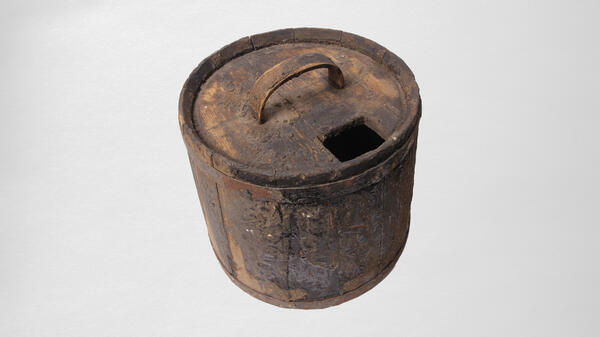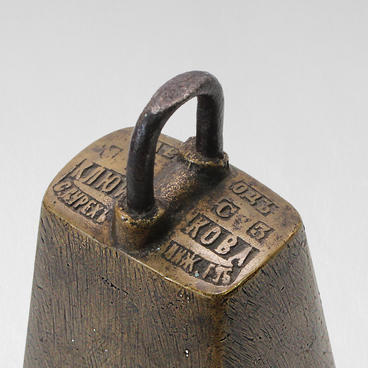The small barrel displayed at the museum’s exhibition was used by gold prospectors. The top cover has a rectangular hole through which the vessel was filled, and a birch bark handle — it is fixed on the inside through holes. The small barrel still smells like tar because it was used for its transportation and storage. Tar for gold miners served as a medicine and protection against gnat in taiga.
Barrels appeared in antiquity, but researchers still argue about the exact time of their invention. Many believe that this wooden container was invented in the 4th century BC by the nephew and disciple of Plato, the ancient Greek philosopher Speusippus of Athens. Others argue that at that time, barrels were already common and in great demand: they were used to store grain and other bulk products and transport liquids; in addition, they were used as a measure of volume and even used to punish and torture people. According to another version, barrels in the form in which they are known today appeared at the beginning of the 1st millennium AD among the Gauls and Franks.
Since ancient times, the technology for assembling barrels has not fundamentally changed. Depending on the required volume, the craftsmen prepared a certain number of wooden bars — thin plates. Then, plates were assembled in a frame and heated with an open fire: the heated wood softened and became elastic. At this stage, the bars were pulled together and fixed with metal hoops or strong ropes, and then, the bottoms were inserted and the rest of the hoops were fitted. At the same time, the hoops had an arched (rolled) edge to repeat the outer silhouette of the barrel. To prevent the vessel from leaking, the gaps between the rivets were sealed with matting, reed, resin, or clay.
Wooden vessels were much stronger and more durable than clay and ceramic containers. When people discovered the taste preserving and conservation properties of oak, the barrel became an indispensable attribute for aging noble alcoholic beverages. The high demand for this simple wooden container remained until the end of the 19th century. Later, wooden barrels were replaced by other types of dishware made of modern materials: enamel, plastic and glass.
Barrels appeared in antiquity, but researchers still argue about the exact time of their invention. Many believe that this wooden container was invented in the 4th century BC by the nephew and disciple of Plato, the ancient Greek philosopher Speusippus of Athens. Others argue that at that time, barrels were already common and in great demand: they were used to store grain and other bulk products and transport liquids; in addition, they were used as a measure of volume and even used to punish and torture people. According to another version, barrels in the form in which they are known today appeared at the beginning of the 1st millennium AD among the Gauls and Franks.
Since ancient times, the technology for assembling barrels has not fundamentally changed. Depending on the required volume, the craftsmen prepared a certain number of wooden bars — thin plates. Then, plates were assembled in a frame and heated with an open fire: the heated wood softened and became elastic. At this stage, the bars were pulled together and fixed with metal hoops or strong ropes, and then, the bottoms were inserted and the rest of the hoops were fitted. At the same time, the hoops had an arched (rolled) edge to repeat the outer silhouette of the barrel. To prevent the vessel from leaking, the gaps between the rivets were sealed with matting, reed, resin, or clay.
Wooden vessels were much stronger and more durable than clay and ceramic containers. When people discovered the taste preserving and conservation properties of oak, the barrel became an indispensable attribute for aging noble alcoholic beverages. The high demand for this simple wooden container remained until the end of the 19th century. Later, wooden barrels were replaced by other types of dishware made of modern materials: enamel, plastic and glass.



